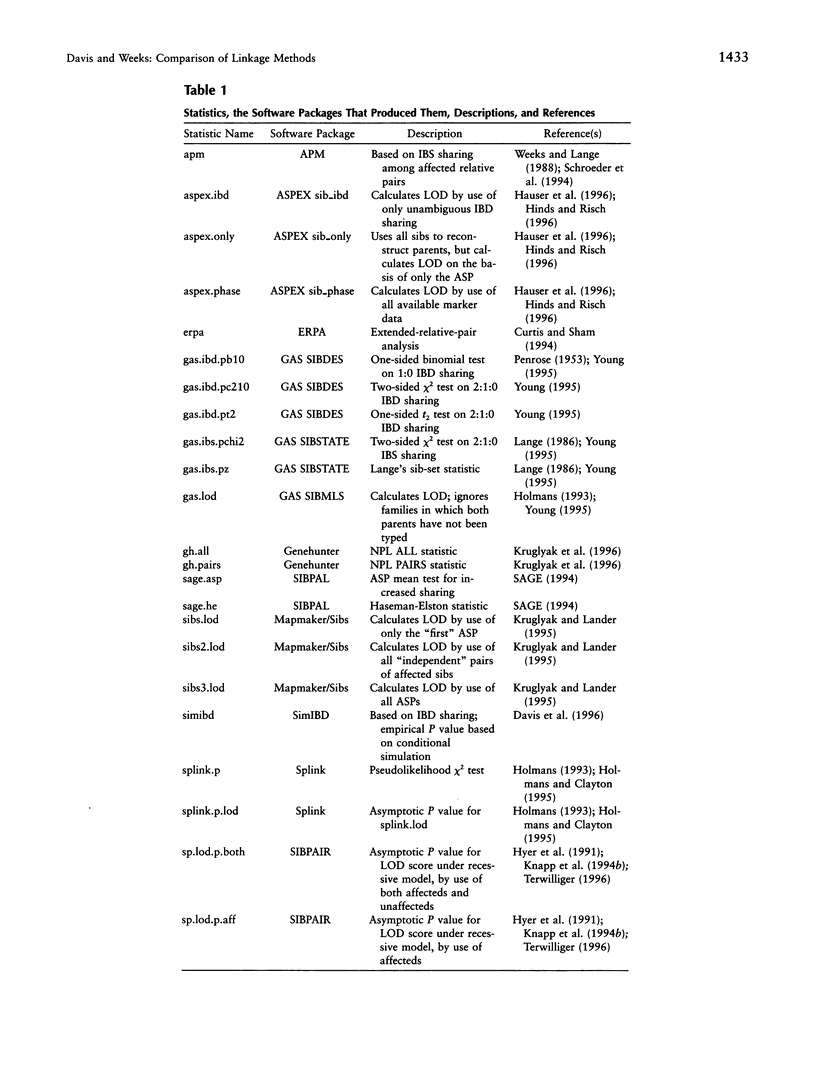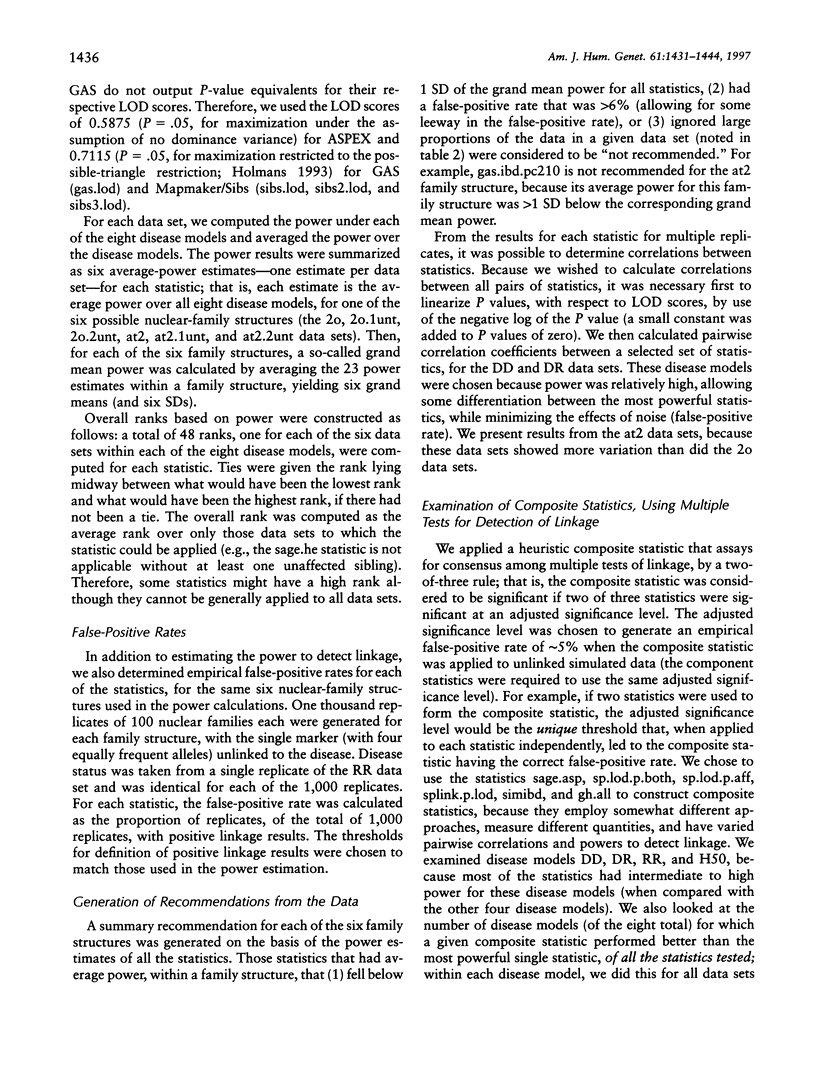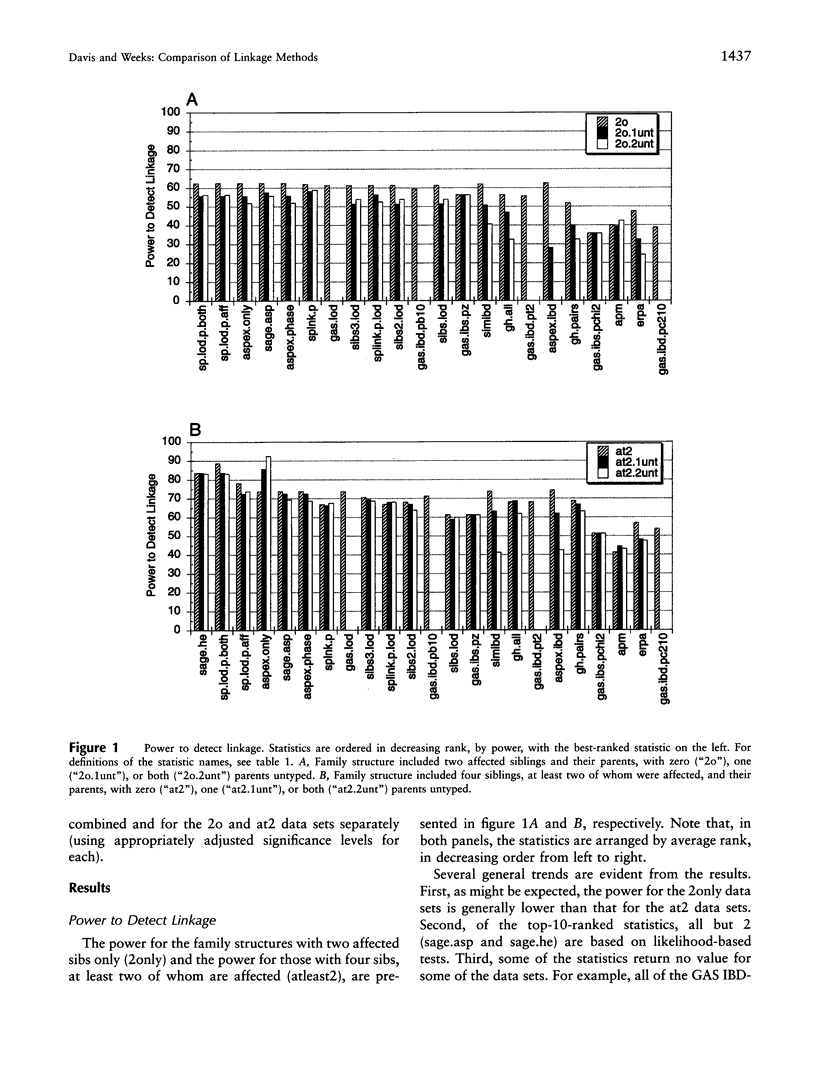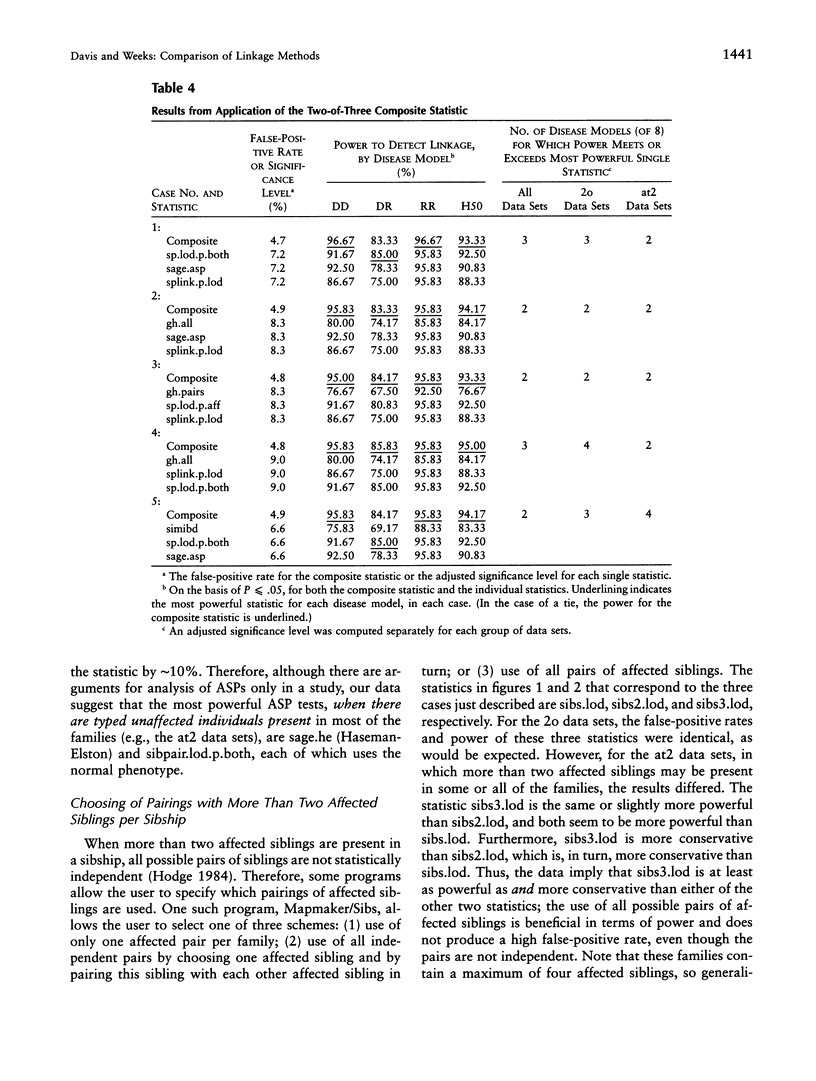Abstract
We have evaluated 23 different statistics, from a total of 10 popular software packages for model-free linkage analysis of nuclear-family data, by applying them to single-marker data simulated under several two-locus disease models. The statistics that we examined fall into two broad categories: (1) those that test directly for increased identity-by-state or identity-by-descent sharing (by use of the programs APM, Genetic Analysis System [GAS] SIBSTATE and SIBDES, SAGE SIBPAL, ERPA, SimIBD, and Genehunter NPL) and (2) those that are based on likelihood-ratio tests and that report LOD scores (by use of the programs Splink, SIBPAIR, Mapmaker/Sibs, ASPEX, and GAS SIBMLS). For each of eight two-locus disease models, we analyzed six data sets; the first three data sets consisted of two-child families with both sibs affected and zero, one, or both parents typed, whereas the other three data sets consisted of four-child families with at least two affected sibs and zero, one, or both parents typed. We report false-positive rates, overall rank by power, and the power for each statistic. We give rough recommendations regarding which programs provide the most powerful tests for linkage, as well as the programs to be avoided under certain conditions. For the likelihood-ratio-based statistics, we examined the effects of various treatments of sibships with multiple affected individuals. Finally, we explored the use of some simple two-of-three composite statistics and found that such tests are of only marginal benefit over the most powerful single statistic.
Full text
PDF













Selected References
These references are in PubMed. This may not be the complete list of references from this article.
- Blackwelder W. C., Elston R. C. A comparison of sib-pair linkage tests for disease susceptibility loci. Genet Epidemiol. 1985;2(1):85–97. doi: 10.1002/gepi.1370020109. [DOI] [PubMed] [Google Scholar]
- Curtis D., Sham P. C. Using risk calculation to implement an extended relative pair analysis. Ann Hum Genet. 1994 May;58(Pt 2):151–162. doi: 10.1111/j.1469-1809.1994.tb01884.x. [DOI] [PubMed] [Google Scholar]
- Davies J. L., Kawaguchi Y., Bennett S. T., Copeman J. B., Cordell H. J., Pritchard L. E., Reed P. W., Gough S. C., Jenkins S. C., Palmer S. M. A genome-wide search for human type 1 diabetes susceptibility genes. Nature. 1994 Sep 8;371(6493):130–136. doi: 10.1038/371130a0. [DOI] [PubMed] [Google Scholar]
- Davis S., Schroeder M., Goldin L. R., Weeks D. E. Nonparametric simulation-based statistics for detecting linkage in general pedigrees. Am J Hum Genet. 1996 Apr;58(4):867–880. [PMC free article] [PubMed] [Google Scholar]
- Ebers G. C., Kukay K., Bulman D. E., Sadovnick A. D., Rice G., Anderson C., Armstrong H., Cousin K., Bell R. B., Hader W. A full genome search in multiple sclerosis. Nat Genet. 1996 Aug;13(4):472–476. doi: 10.1038/ng0896-472. [DOI] [PubMed] [Google Scholar]
- Feingold E., Siegmund D. O. Strategies for mapping heterogeneous recessive traits by allele-sharing methods. Am J Hum Genet. 1997 Apr;60(4):965–978. [PMC free article] [PubMed] [Google Scholar]
- Field L. L., Tobias R., Thomson G., Plon S. Susceptibility to insulin-dependent diabetes mellitus maps to a locus (IDDM11) on human chromosome 14q24.3-q31. Genomics. 1996 Apr 1;33(1):1–8. doi: 10.1006/geno.1996.0153. [DOI] [PubMed] [Google Scholar]
- Goldin L. R., Weeks D. E. Two-locus models of disease: comparison of likelihood and nonparametric linkage methods. Am J Hum Genet. 1993 Oct;53(4):908–915. [PMC free article] [PubMed] [Google Scholar]
- Haines J. L., Ter-Minassian M., Bazyk A., Gusella J. F., Kim D. J., Terwedow H., Pericak-Vance M. A., Rimmler J. B., Haynes C. S., Roses A. D. A complete genomic screen for multiple sclerosis underscores a role for the major histocompatability complex. The Multiple Sclerosis Genetics Group. Nat Genet. 1996 Aug;13(4):469–471. doi: 10.1038/ng0896-469. [DOI] [PubMed] [Google Scholar]
- Hashimoto L., Habita C., Beressi J. P., Delepine M., Besse C., Cambon-Thomsen A., Deschamps I., Rotter J. I., Djoulah S., James M. R. Genetic mapping of a susceptibility locus for insulin-dependent diabetes mellitus on chromosome 11q. Nature. 1994 Sep 8;371(6493):161–164. doi: 10.1038/371161a0. [DOI] [PubMed] [Google Scholar]
- Hauser E. R., Boehnke M., Guo S. W., Risch N. Affected-sib-pair interval mapping and exclusion for complex genetic traits: sampling considerations. Genet Epidemiol. 1996;13(2):117–137. doi: 10.1002/(SICI)1098-2272(1996)13:2<117::AID-GEPI1>3.0.CO;2-5. [DOI] [PubMed] [Google Scholar]
- Hodge S. E. The information contained in multiple sibling pairs. Genet Epidemiol. 1984;1(2):109–122. doi: 10.1002/gepi.1370010203. [DOI] [PubMed] [Google Scholar]
- Holmans P. Asymptotic properties of affected-sib-pair linkage analysis. Am J Hum Genet. 1993 Feb;52(2):362–374. [PMC free article] [PubMed] [Google Scholar]
- Holmans P., Clayton D. Efficiency of typing unaffected relatives in an affected-sib-pair linkage study with single-locus and multiple tightly linked markers. Am J Hum Genet. 1995 Nov;57(5):1221–1232. [PMC free article] [PubMed] [Google Scholar]
- Hyer R. N., Julier C., Buckley J. D., Trucco M., Rotter J., Spielman R., Barnett A., Bain S., Boitard C., Deschamps I. High-resolution linkage mapping for susceptibility genes in human polygenic disease: insulin-dependent diabetes mellitus and chromosome 11q. Am J Hum Genet. 1991 Feb;48(2):243–257. [PMC free article] [PubMed] [Google Scholar]
- Knapp M., Seuchter S. A., Baur M. P. Linkage analysis in nuclear families. 1: Optimality criteria for affected sib-pair tests. Hum Hered. 1994 Jan-Feb;44(1):37–43. doi: 10.1159/000154187. [DOI] [PubMed] [Google Scholar]
- Kruglyak L., Daly M. J., Reeve-Daly M. P., Lander E. S. Parametric and nonparametric linkage analysis: a unified multipoint approach. Am J Hum Genet. 1996 Jun;58(6):1347–1363. [PMC free article] [PubMed] [Google Scholar]
- Kruglyak L., Lander E. S. Complete multipoint sib-pair analysis of qualitative and quantitative traits. Am J Hum Genet. 1995 Aug;57(2):439–454. [PMC free article] [PubMed] [Google Scholar]
- Lange K. A test statistic for the affected-sib-set method. Ann Hum Genet. 1986 Jul;50(Pt 3):283–290. doi: 10.1111/j.1469-1809.1986.tb01049.x. [DOI] [PubMed] [Google Scholar]
- Martinez M., Goldin L. R. Power of the linkage test for a heterogeneous disorder due to two independent inherited causes: a simulation study. Genet Epidemiol. 1990;7(3):219–230. doi: 10.1002/gepi.1370070306. [DOI] [PubMed] [Google Scholar]
- PENROSE L. S. The general purpose sibpair linkage test. Ann Eugen. 1953 Sep;18(2):120–124. [PubMed] [Google Scholar]
- Risch N. Linkage strategies for genetically complex traits. II. The power of affected relative pairs. Am J Hum Genet. 1990 Feb;46(2):229–241. [PMC free article] [PubMed] [Google Scholar]
- Schroeder M., Brown D. L., Weeks D. E. Improved programs for the affected-pedigree-member method of linkage analysis. Genet Epidemiol. 1994;11(1):69–74. doi: 10.1002/gepi.1370110107. [DOI] [PubMed] [Google Scholar]
- Schwab S. G., Albus M., Hallmayer J., Hönig S., Borrmann M., Lichtermann D., Ebstein R. P., Ackenheil M., Lerer B., Risch N. Evaluation of a susceptibility gene for schizophrenia on chromosome 6p by multipoint affected sib-pair linkage analysis. Nat Genet. 1995 Nov;11(3):325–327. doi: 10.1038/ng1195-325. [DOI] [PubMed] [Google Scholar]
- Stine O. C., Xu J., Koskela R., McMahon F. J., Gschwend M., Friddle C., Clark C. D., McInnis M. G., Simpson S. G., Breschel T. S. Evidence for linkage of bipolar disorder to chromosome 18 with a parent-of-origin effect. Am J Hum Genet. 1995 Dec;57(6):1384–1394. [PMC free article] [PubMed] [Google Scholar]
- Ward P. J. Some developments on the affected-pedigree-member method of linkage analysis. Am J Hum Genet. 1993 Jun;52(6):1200–1215. [PMC free article] [PubMed] [Google Scholar]
- Weeks D. E., Lange K. The affected-pedigree-member method of linkage analysis. Am J Hum Genet. 1988 Feb;42(2):315–326. [PMC free article] [PubMed] [Google Scholar]
- Weeks D. E., Lathrop G. M. Polygenic disease: methods for mapping complex disease traits. Trends Genet. 1995 Dec;11(12):513–519. doi: 10.1016/s0168-9525(00)89163-5. [DOI] [PubMed] [Google Scholar]
- Whittemore A. S., Halpern J. A class of tests for linkage using affected pedigree members. Biometrics. 1994 Mar;50(1):118–127. [PubMed] [Google Scholar]


